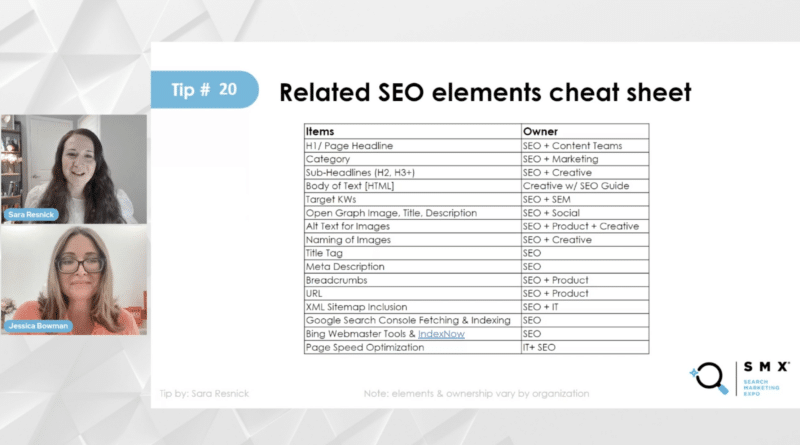
30 ways enterprise organizations can grow SEO with limited resources
Making the most of your SEO strategy with limited resources can be challenging.
However, there are simple and cost-effective actions you can pursue to tackle common hurdles in resource-constrained enterprise organizations.
Incorporating AI to save time and establishing smoother cross-department communication for enhanced efficiency are some effective steps.
Jessica Bowman, an enterprise SEO consultant, and Sara Resnick, global head of organic growth at Shutterstock, shared 30 valuable tips and actionable techniques you can immediately implement at SMX Advanced.
1. Differentiate yourself when using AI
When using AI for content, add unique facts, data, and expertise your brand possesses rather than letting the AI recycle the same generic information – which it may also offer to your rivals.
2. Use AI as your content intern
Treat AI like an intern gathering basic information. Then make the content uniquely yours by adding proprietary data, fresh angles and expert polish.
AI gets you started, but partnering it with human creativity produces distinctive content that stands out.
3. AI prompts for content assistance
AI can greatly assist SEOs and make their jobs easier in many ways using prompts, such as:
- Keyword research
- Classify query intent (knowing what’s informational, navigational, transactional)
- Correlated queries and questions
- Content ideation
- Coding
4. Use AI prompts for HTML assistance
You can use AI prompts for HTML assistance, such as requesting header tags for breaking up articles and generating headlines. But it’s essential to proofread and view AI as collaborative support rather than a word-for-word substitute.
Additionally, schema markup simplification, especially for events, is facilitated by AI, aiding in generating schema markup for specific scenarios.

5. Content inventory and upcycle
Perform a content audit and refresh to make existing content relevant again by following these steps:
- Check what old content is ranking for and any backlinks to it.
- If refreshing the content, update it to be useful for today’s audience.
- If not refreshing it, properly 301 redirect or 404/410 error code old unwanted content.
- Quality assurance is important to ensure refreshed content is high-quality.
- Make sure refreshed content is in XML sitemaps and interlinking so search engines can find and crawl it.
6. Internal and external linking
Make sure you are leveraging internal linking to connect priority pages. Over-educate teams on key pages and terms they should be linking to – especially those that may not have a solid understanding of SEO.
Also, cross-collaborate on SEO to inform content and PR, and encourage external partnerships to link for greater brand authority.
Don’t forget to monitor changes to top navigation links. This can sometimes change without your knowledge, so make sure that everyone is aware of how important interlinking and anchor text is.
7. Social in search
Be aware of your social media presence in search engine results pages (SERPs).
Test how your brand appears on platforms like Instagram, Facebook, TikTok and YouTube when you perform branded searches. And make sure you take note of the differences between mobile and desktop results.
YouTube, being the second-largest search engine, holds particular significance. Make sure your brand’s visibility is consistent and effective across these platforms to enhance your brand authority.
8. Testimonials and reviews
The introduction of the additional E in E-E-A-T refers to experience, which is why ratings and reviews are so important. On Amazon, in particular, these elements have a significant influence on converting browsers into customers.
Implementing schema reviews markup can significantly boost click-through rates.
Additionally, focusing on branded queries and combining them with reviews and customer service is crucial. Ensuring the right teams are involved helps maintain brand authority and reputation alignment.

9. Trustworthy branding
Making users feel secure is vital. Ensure your branding reflects this and highlight its importance within your team.
Also, remember to be responsive to unhappy customers. This not only relates to customer service but impacts search results and shows your commitment to customer care, enhancing trustworthiness.
10. Automation and bulk realizations
When you’re dealing with limited bandwidth, automation becomes a key player in streamlining processes.
Think about categories as a whole, such as the background category, and identify related pages. Analyze associations, prioritize interlinking, and optimize your keyword set across pages for a comprehensive strategy.
Simplify title tag adjustments in a spreadsheet for bulk uploads – this is an efficient approach to fine-tune your strategy. Also, consider seasonal cleanups, especially for large websites where crawlability is a concern.
Review pages with no clicks over 12 to 16 months, tailor your strategy, communicate it internally, and ensure no one else needs the page before retiring it.
11. Everything is connected: Look at your site as a whole
Remember, your website is a network of connections. When optimizing, think big and tackle multiple pages at once. When launching new collections, cover everything: title tags, descriptions, on-page content, team communication and interlinking.
But watch out for content overlap. Introduce new pages smartly by identifying competing topics that need interlinks. Keep the site clean by retiring old elements.
12. Scaling content tips
Here are three helpful ways to scale your content effectively:
- Always keep non-transactional keywords handy, even if they’re not relevant immediately.
- Utilize your marketing channels, like email, PR and paid media to support your content strategy.
- User-generated content (UGC) and influencer-generated content (IGC) can enhance your brand narrative and authority.
Adapting your processes to include SEO is crucial.
13. Integrate SEO into official processes/workflows
Take a broader view across the organization to spot recurring workflows that might be causing SEO issues and nip those problems in the bud. The goal is to seamlessly incorporate SEO into these processes and tackle problems head-on.
An audit of these workflows is key. Often, this means focusing on content creation, development and more. Consider what needs to be done for SEO at each step, clarifying roles for the SEO team and others.
Here are a few common workflows to consider:
- Content strategy
- URL creation
- Sunsetting URLs
- Launching new pages
- Tackling new, larger projects
14. Get product managers to own certain metrics important to SEO
Some metrics vital for SEO success don’t necessarily need SEO expertise to act upon. These are like indicators of your website’s health.
Product managers or developers can take the reins here. The trick is to add these metrics to their dashboards and prompt them to take action if things go awry.
The key? Get executive backing to make this happen.
Product managers don’t need to be SEO gurus, but they should understand the importance. Think of it this way: you’re entrusting them with responsibilities, not passing the buck. Consider metrics like core web vitals, site errors and XML site issues.
Set up dashboards, maybe using tools like Domo, and trigger alerts for problem thresholds. Remember, it’s about delegation, not just handing off. The best SEO managers stay watchful while sharing the load.

15. Teach other roles to recognize when to pull in the SEO team
Train other departments to recognize when they should pull in the SEO team on a particular project or task. Consider creating a cheat sheet to use to help them identify these situations.
16. Automation from product and development
Test how you can speed up some of your processes for best practices.
For example, if you have an XML sitemap, see if your tech teams can automate the process and that you’re continuously checking on them. You can also call in AI for help on tasks like cranking out schema markup.
However, make sure that your product team’s in on this too, aligning the stars with IT rules. And don’t forget inventory management, a big deal for what’s in and out of stock.
Everyone should be on the same page, and automation can make sure your SEO game stays strong, even if something’s temporarily missing or gone for good.
17. Commit to training every new hire that influences SEO
The duo shared three ways to make this happen:
- Personalized training: Give the VIP treatment to key players like top-notch product managers. Think of the folks behind your product and search result pages. They’re SEO champs.
- Virtual learning: Set up training modules online. You can turn in-person sessions into snazzy online courses. Plus, you can tailor-make modules just for the online platform. And don’t forget to loop in managers for a seamless rollout.
- Annual SEO training: Work with HR or team managers to integrate this into your company’s standard onboarding process, and within a year or two, you’ll be left with a team of educated SEO advocates.
18. Set up SEO certification for all roles
For the roles that impact SEO the most, certify them but have the certification ready to go immediately after the SEO training. But make participation meaningful. Perhaps, give some type of reward for completion (e.g., gift cards).
19. Train executives on the right things
Get executives to start thinking like SEO leaders. During their training, encourage them to ponder important questions:
- How should they approach SEO at a leadership level?
- Are their teams boosting SEO, holding it back, or maybe even affecting revenue negatively?
The goal is to make them think not just about the basics of SEO, but about where their teams fit within the entire organization.
20. Related SEO elements cheat sheets
Resnick shared a handy cheat sheet for SEO:

Explain to your team how the elements listed impact SEO but make sure you tailor the sheet first for your company’s specific needs.
21. Create a chat channel for SEO
Get your team excited about SEO by cultivating a supportive environment, such as an SEO-dedicated Slack channel. This will help ensure the SEO department is easy to approach, quick to answer queries and have backup teammates for when you’re busy.
22. Send SEO updates to each role as they are relevant
Keep your SEO team in the loop with timely updates. For instance, let them know that Google’s replacing importance on FID with INP and Core Web Vitals.
If you use internal trackers, ensure the updates are accessible. Once news hits, spread the word to developers, product managers, and relevant teams, and make sure they’re discussing it in their meetings.
23. Get really good at writing SEO tickets
Master the art of writing SEO tickets – it’s a key area where many SEO teams run into problems.
Dedicate time to not only improve your skills but also to craft effective tickets. This can help improve efficiency and prevent unnecessary delays.
24. Get really good at QA testing
The best-in-class SEO teams do their own QA testing, Bowman said. This is crucial for validating the accuracy of your SEO tickets.
Often, SEO teams struggle with QA testing due to incomplete tests or lack of time and expertise. Rushing, inadequate knowledge or delayed testing can result in critical issues being discovered too late.
Some SEO team members might lack the technical SEO knowledge, while others are simply too busy for thorough testing.
It’s important to acknowledge that the SEO team should take the lead in comprehensive QA testing. While some tests can involve QA testers, top-notch SEO teams handle their own QA testing, as leaving it entirely to QA testers might lead to important issues being overlooked.

25. Get really good at writing user acceptance criteria
This is closely tied to strong QA testing. In an agile setup, your role includes composing the user story and its acceptance criteria. These criteria serve as the developers’ reference for ensuring their code aligns with expectations.
Every SEO ticket must include these requirements and acceptance criteria to prevent errors during development. Becoming proficient in this process is vital to minimize mistakes and ensure seamless implementation.
26. If development introduces problems, get a tool to monitor the code
If you’ve ever encountered problems (e.g., launching new feature on site only for them to vanish a few months later due to development-related issues), get a code-monitoring tool. Your IT department might already have one, so it’s worth exploring to save costs.
However, you won’t have full control to set up tests yourself; so collaboration with IT is essential.
Alternatively, you can opt for a tool like SEO Radar, which validates SEO and detects changes. This is particularly useful when things suddenly disappear from your site, as in the case of my client’s missing hreflang sections.
27. Send dashboard alerts
Instead of having everyone constantly log into an SEO tool for alerts, set up dashboard notifications. Send these alerts directly to the teams that can address them.
Collaborate with executives to ensure they take action on issues that don’t demand SEO expertise.
You can easily distribute this responsibility among developers, product owners and managers.
28. Mashup data from different tools
You might be juggling five different SEO monitoring tools. Grab their APIs and bring all the data into a single tool, preferably the one that your product managers and developers are already using, like Domo.
This way, it’s a breeze to hold other teams accountable since they’re already accustomed to checking these dashboards regularly.
29. Annotations and event tracking
In the fast-paced world of SEO, a lot is going on. So keeping tabs on your events is crucial.
For example, a list of Google algorithm updates can be shared with your teams, encouraging them to add these events as annotations in tools like Google Analytics or your chosen tracking platforms.
Another valuable practice is implementing event tracking across your website, especially for product releases. This allows you to identify correlations between events and any observed decreases in performance.
30. Maximize your time management
To get the most bang for your buck, ensure you efficiently use the time of your SEO team, internal colleagues, agencies and freelancers.
Recognizing the strengths of different team members, from senior experts to those newer to the field, enables you to leverage their skills effectively. For agency collaborations, prioritize higher-level tasks that align with your budget allocation.
Additionally, smart time management and execution are key, particularly for launches and projects. When working within tight timelines, the following are essential for successful execution:
- Set realistic timeframes.
- Send well-timed meeting invites.
- Maintain a strategic approach.
This approach underscores the importance of efficient time allocation for accomplishing goals.
The post 30 ways enterprise organizations can grow SEO with limited resources appeared first on Search Engine Land.
from Search Engine Land https://searchengineland.com/enterprise-organizations-grow-seo-limited-resources-431237
via free Seo Tools